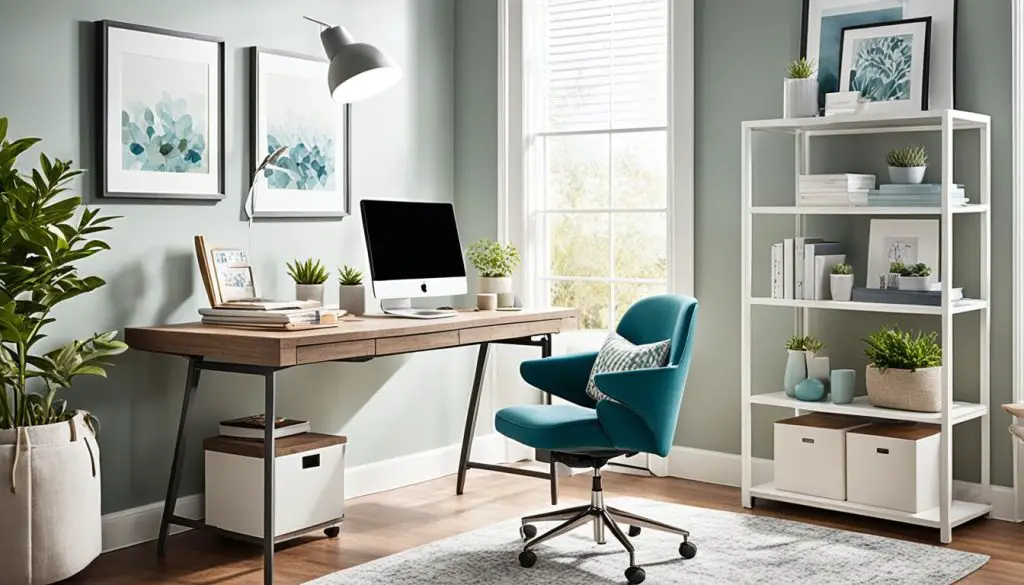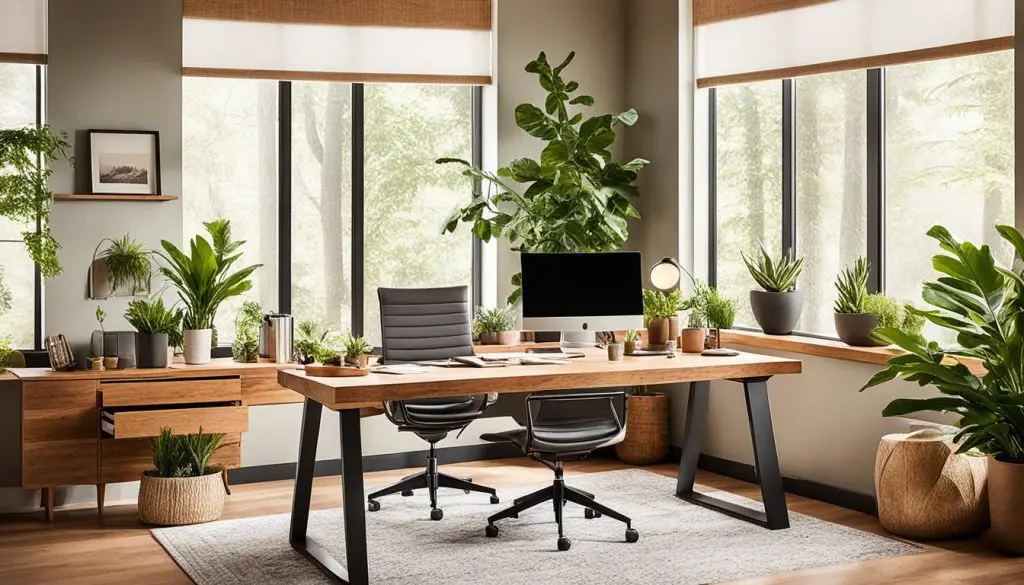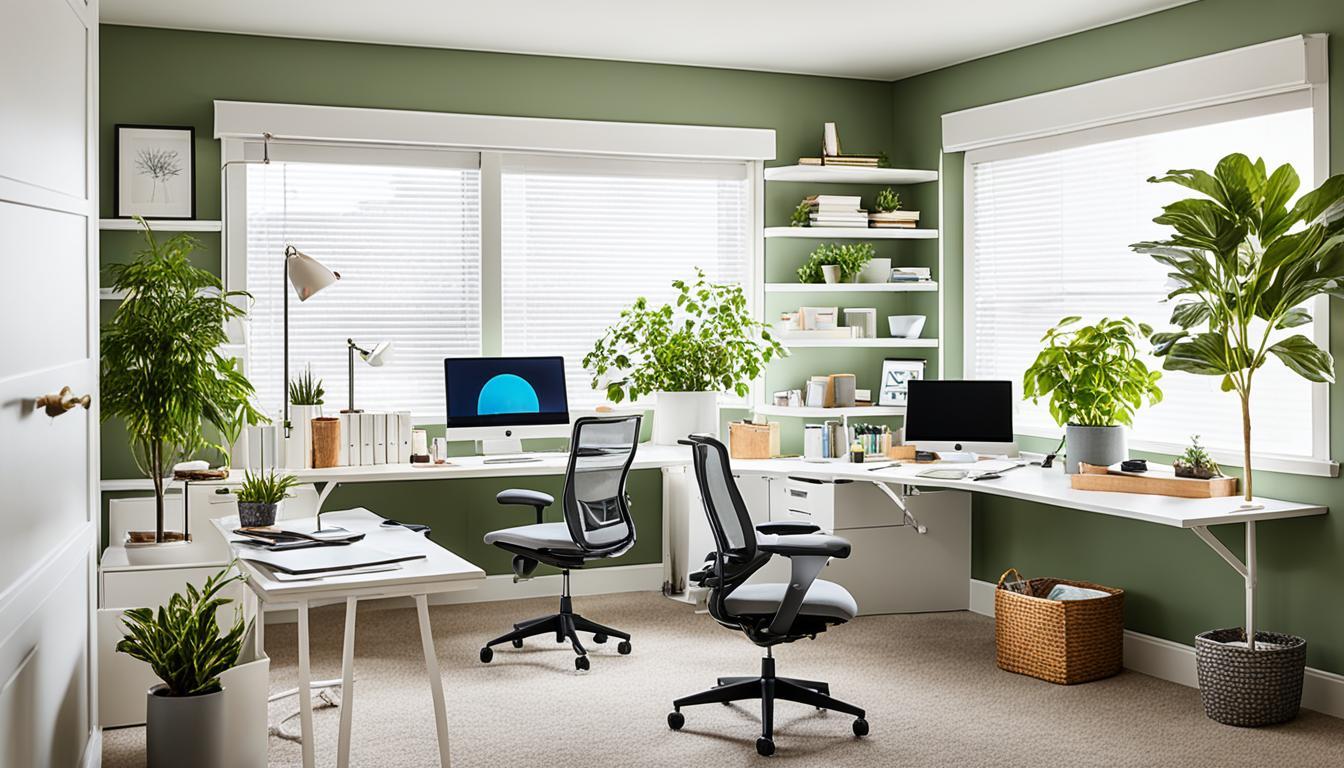Ever thought about how your home office could change the way you deal with a chronic illness? I, too, have seen the difference it makes. Personalizing your workspace can really boost your comfort, productivity, and health. Making ergonomic changes specific to your needs creates a place that keeps you physically, mentally, and emotionally well.
This piece shows how changing your home’s design can help those with migraines, chronic pain, and more. Our aim is to offer easy steps to create an office that helps you heal and relax. We want to boost your life’s quality with these tips.1
So, how does your home office help you succeed, even with a chronic disease? Get ready to discover how your work area can make all the difference. You might just reach new levels with your personal space.1
Introduction to Chronic Illness and Its Impact
Chronic illnesses can change life drastically. They affect not just the body but also how we feel and connect with others. Conditions such as migraines, chronic pain, depression, and cancer can turn daily tasks into challenges.2
What is Chronic Illness?
Chronic pain keeps going for more than 3 months. It includes conditions like fibromyalgia and chronic back pain.2 We also have arthritis, diabetes, heart disease, and asthma as common chronic illnesses.
Types of Chronic Illnesses
According to the World Health Organization, chronic diseases cause most deaths worldwide. They lead to about 41 million people dying each year. More than 15 million of these deaths are in people aged 30 to 69.2
25% of adults have one or more chronic health conditions. This puts a lot of pressure on everyone, from individuals to families and healthcare systems.2
How Chronic Illness Affects Daily Life
Conditions like heart disease, cancer, and diabetes are top causes of death and disability. Early diagnosis and treatment are key to manage symptoms and live better. If you think you have a chronic illness, see a doctor.
The Importance of a Personalized Home Office
For people dealing with long-term sickness, having a special space to work at home is game-changing. A work area crafted just for them boosts how well they work, relax, and feel.3 It features comfy setups, deals with their symptoms, and includes designs that fit just them. This talk dives into how having a workspace designed for you makes dealing with health issues better and improves life quality.
Did you know, about 30% of hospital visits again could have been avoided? This says people can look after their health better with the right care. Plus, about half those surveyed needed costly follow-up care after a health scare, especially paid for by Medicaid.3 So, by setting up a place at home that’s just right, managing health issues gets easier and may stop these costly visits.
Having a workspace that suits your health needs does more good than you might think. People with expensive unplanned care often change their health plans. This shows how fixing your workspace affects your health and happiness.3 So, making a space that really meets your needs brings joy, control, and strength. And for those with health problems, that can mean a lot.
So, a solo office at home is not just any work area; it’s a healing space.3 Designing it to meet your mental, emotional, and physical needs changes life for the better. Making it right boosts work, cuts down on symptoms, and makes life sweeter.
Migraines and Home Office Design
Do you live with migraines? Then, how your home office is designed matters a lot. It impacts how you manage symptoms and feel every day.4 Pay close attention to the lighting. Bright or flickering lights might set off a migraine. So, create a calming space with soft lights. You could use dimmable lamps or enjoy the sun for a more soothing feel.
Colors in your space can also help. Studies show that calming shades of blue and green might ease migraine pain.4 It’s important to make sure the air you breathe is clean and fresh. Bad air and irritants can make migraines worse.4 By focusing on these factors, you can set up a home office that helps you heal and avoid triggers.
| Design Element | Impact on Migraines | Recommended Approach |
|---|---|---|
| Lighting | 4 Bright or flickering lights can trigger and exacerbate migraine episodes. | 4 Incorporate soft, indirect lighting, such as dimmable lamps or natural sunlight. |
| Color Therapy | 4 Certain calming hues like blues and greens can help alleviate migraine pain. | Utilize a color palette with soothing, calming tones. |
| Ventilation and Air Quality | 4 Poor air circulation and exposure to irritants can worsen migraine symptoms. | 4 Ensure proper ventilation and maintain high air quality in the home office. |
Chronic Pain and Ergonomics
If you have chronic pain like fibromyalgia or back pain, your home office’s design is key for managing symptoms and feeling better.5 It’s important to control lighting and temperature because bad lighting and too hot or cold rooms can make pain worse. Having lights and heating you can adjust helps a lot.5
Lighting and Temperature Control
Using ergonomic furniture like adjustable desks and chairs can reduce stress on your body.5 Also, choosing soothing colors and patterns can calm you and help with pain.5 Making your workspace comfortable and personalized boosts your work and life quality.
Ergonomic Furniture and Accessories
Pattern and Color for Pain Relief
Picking soothing colors and patterns, especially blues and greens, can lessen your pain.5 Adding these elements to your office makes it a peaceful place that’s good for your health.
Cancer and Creating a Comforting Space
For those living with cancer, a home office can become a peaceful retreat.6 It’s key to set it up for both physical and emotional health. Fill it with items that bring comfort, like cozy chairs, soft fabrics, and gentle lights.6 Using calm colors and natural textures adds to the peace.6 Placing furniture, lights, and decorations thoughtfully fosters a serene spot. Here, people with cancer can relax and focus on getting better.
Comfort and Relaxation
Making the space cozy and uplifting helps cancer patients feel better.6 Add in soft music and scents with aromatherapy for extra calmness.6
Calming Colors and Textures
Soft colors and nature’s materials, like wood and fabrics, soothe the mind.6 They work together to make a healing space6 where cancer patients can concentrate on getting well.
Harmony and Serenity
Being smart about where you put things helps the office feel balanced and peaceful.6 This approach to design lowers stress and creates a cozy place for those fighting cancer.
Mental Health Disorders and Home Office Design
For people living with anxiety or depression, the design of their home workspace is crucial. Design affects well-being greatly. It doesn’t just mean physical health but also mental, social, and spiritual wellness.7 A home office that considers these aspects becomes a space for healing.
Color Therapy for Mental Well-being
Color therapy studies how colors impact our mind and body. Using calming colors like blues and greens can lower stress and anxiety.7 When done right, the design of a space can even help manage migraines, pain, and depression.7
Layout and Organization
The way the workspace is set up matters a lot. It should be free of clutter with plenty of natural light. There must be areas for both relaxation and focus.8 Thinking ahead to avoid major disruptions is key.

Clinical Depression and Biophilic Design
Living with clinical depression makes a home office’s design very important. Biophilic design brings nature indoors and helps improve mental health. This can mean a lot to someone battling depression.9
The Importance of Natural Light
Natural light from big windows or skylights is key. It helps keep our body’s daily rhythms on track and make us feel better.9 For those dealing with depression, being in natural light can be soothing. It helps them feel a bit brighter.
Incorporating Nature into Your Space
Adding plants, water features, or wooden elements offers a touch of nature indoors. This can make a space feel more peaceful and connected to the outside world.9 It’s a way to fight loneliness and the sense of being cut off that depression can bring.
Temperature Control and Air Quality
Good air and temperature in the home office are also vital for comfort. This is especially true for those facing depression.9 A well-ventilated, warm space helps people relax and focus on getting better.
Personalizing Home Office Chronic Illness
Setting up a home office for10 chronic illness can truly transform someone’s life. It inverts the space into one that champions an individual’s well-being. With thoughtful design tweaks, those with10 chronic illnesses shape a workplace that bolsters their body and mind. This section offers a glance at crucial steps and ideas. It arms readers to start their own journey towards a work area that amplifies healing and health.
For people facing illnesses like migraines, chronic pain, or depression, a well-designed work area is a game changer. It influences how symptoms are managed and how much work gets done. Adding ergonomic furniture, calming colors, and bits of nature turn a workspace into a healing zone. Customizing it also hands back a sense of power. Folks get to choose what works best to support their health.
Perfecting the light, temperature, and adding self-care corners makes the office a supportive place. By using natural materials and bringing nature inside, the workplace isn’t just better for work, but also for health. These design tips help create a space that boosts productivity while taking care of both body and mind.
The process of personalizing the home office for chronic illness is more than just decorating. It’s about improving life quality drastically. This part has shared all the essential tips and ideas to guide readers. It gives them the push to turn their workspace into a healing, wellness oasis.
Introduction to Holistic Design Approach
Designing a home office for someone with8 chronic illness requires a holistic approach. It focuses on how the space affects physical, mental, emotional, and social health. This approach aims to support overall well-being, not just look good or work well. It means creating a room that brings balance, comfort, and healing to people with long-term health issues.
Defining Holistic Design
Holistic design looks at the complete person, not just their physical needs. It combines different elements to form a balanced and supportive space. This approach targets an individual’s well-being in all areas.
Benefits of Holistic Design for Chronic Illness
A holistic design can greatly benefit those with8 chronic illness. It can lower stress, manage symptoms better, and increase their quality of life. By meeting physical, mental, emotional, and social needs, a home office can become a place for healing and relaxation. It boosts productivity, too. Adding natural design, easy-to-use furniture, and personal touches enhances the therapeutic feel for these individuals.
The Role of Nature in Biophilic Design
Biophilic design is all about inviting nature into our living and working spaces. It’s great for those with long-term health problems. Studies show it boosts health and mood.11 People feel better when they’re surrounded by nature indoors.12
Biophilic Design Principles
Using things like natural light and views of nature at work can make a huge difference. They help make an office feel peaceful and renewing.119 Adding plants, water features, or natural wood brings the outdoors in. This connection aids in the healing process.11
Incorporating Natural Elements
Bringing nature inside can deeply benefit those with ongoing health issues.1112 Using calming colors and nature-inspired textures helps build a serene space. This kind of design turns an office into a healing sanctuary.119

Research on Natural Light and Sound
Research shows big benefits of natural light and sound at work, especially for those with chronic illnesses.13 Natural light improves our daily body clocks, mood, and health. It helps lessen effects of illnesses such as depression and chronic pain.
Adding calming sounds from nature, like water flowing or birds singing, reduces stress. This approach brings peace and relaxation, which is especially helpful for people with ongoing health issues. Designers can use these natural elements to make a work area better for mental and physical health.
The Impact of Natural Light
Studies based on Kaplan’s work in 2001 show looking at natural views is good for us. Natural light greatly affects our daily rhythm, mood, and health13. This proves that rooms with natural light are healing spaces. They can help with symptoms of diseases like depression and chronic pain.
The Healing Power of Sound
In 1995, Kaplan showed how sounds from nature can restore us. Sounds like water flowing or birds singing calm us and reduce stress. Designers use these kinds of sounds to create calm workspaces. This is especially good for those with chronic illnesses to feel better emotionally and mentally.
Benefits of Natural Materials, Color & Texture
Choosing natural materials, colors, and textures can really help those with chronic illness. Things like wood and natural fabrics make the air cleaner inside. They also lower harmful chemicals and feel nice to touch.8
Natural Materials and Their Advantages
Using these materials at home is a big help. For arthritis, it’s making the kitchen and bathroom easy to reach without bending too much. This means countertop heights that fit, grab bars where needed, and non-slip mats around the house.8
For people with memory issues, a smart home can make life safer. It includes cameras, easy-to-understand pictures, and smart devices. These changes can keep them secure at home.8
Biophilic design, like adding skylights or plants, is good for everyone’s mental health. They bring nature into the house and make us feel better.8
The Psychology of Color
Color is also key to how we feel. Blues and greens relax us. Looking at nature helps, too.14
Bringing nature inside through design can do wonders for our health. It boosts our mood and keeps our mind and body strong.14
Texture and Its Role in Design
Textures matter for comfort. Soft, cozy things make a big difference. Using natural materials in the design helps us relax and feel good.14
Adding these elements to our home office can make it a place of healing. It feeds our senses and makes us well.14
Self-Care Practices and Interior Design
The link between self-care and design is key. It helps create a perfect home working space for those with chronic illness.7 By designing with relaxation and healthy habits in mind, this space can support physical and mental health.7
Creating a Relaxing Environment
Adding elements that encourage relaxation is important. Features like cozy chairs, soft lights, and calm colors help reduce stress.7 They make the room a place of peace, vital for those with ongoing health issues.7
Incorporating Mindfulness Spaces
Having spots for mindful activities like meditation is beneficial. It focuses on mental health.7 Spaces for self-care allow time for emotional nourishment in the comfort of their workspace.7
Promoting Healthy Habits
Designing for healthy habits means choosing ergonomic furniture and adding natural light. These choices boost physical health.7 The office then becomes a place that helps people live healthier, even with health challenges.7
Summary
Personalizing the home office for those with chronic illness changes their life in big ways. It improves their quality of life greatly.15 Designers use a complete design approach. They add elements for people with conditions like migraines, chronic pain, cancer, and mental health issues.15
They make sure the space helps with physical, mental, and emotional health. They improve the lighting and set up the furniture in a way that is good for the body. They also add things to bring nature inside and push self-care practices.15 This makes the personal home office a place for healing and working well.15
This article looks at the ways to make a home office special for those with chronic illness. It covers everything from the design to the objects inside.15 The goal is to help people manage their health and do well at home.15
In short, creating a special home office for those with chronic illness is key. It helps them manage their condition and live better.15 By using a special design, the home office becomes a place of healing for the mind and body.15 This article has offered lots of advice to make a workspace that is perfect for dealing with chronic illness. It’s a guide to making a home a healing space.
Source Links
- https://www.chartspan.com/blog/the-role-of-personalized-healthcare/
- https://www.ncbi.nlm.nih.gov/pmc/articles/PMC10702417/
- https://www.mckinsey.com/industries/healthcare/our-insights/the-role-of-personalization-in-the-care-journey-an-example-of-patient-engagement-to-reduce-readmissions
- https://www.ncbi.nlm.nih.gov/pmc/articles/PMC8297988/
- https://www.ncbi.nlm.nih.gov/pmc/articles/PMC10049341/
- https://instacarehome.com/creating-a-safe-and-healing-environment-tips-for-setting-up-cancer-home-care-in-elizabeth-nj/
- https://www.julieannrachelle.com/blended-decor-blog/wellness-design-for-chronic-illness
- https://liveinplacedesigns.com/how-home-design-can-help-you-live-with-a-chronic-illness-or-condition/
- https://www.ncbi.nlm.nih.gov/pmc/articles/PMC9755679/
- https://doyouendo.com/work-from-home-chronic-illness/
- https://etactics.com/blog/biophilic-design-in-healthcare
- https://www.sharp.co.uk/news-and-events/blog/The-Benefits-of-Biophilic-Design-in-the-Workplace
- https://www.ncbi.nlm.nih.gov/pmc/articles/PMC3072911/
- https://www.sarahbarnard.com/story/tag/designing for mental health
- https://signallamphealth.com/chronic-care-management-the-ultimate-guide/
